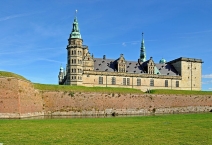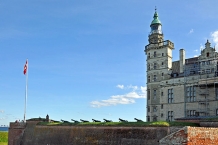Schloss Kronborg
Worth visiting
Added on 15 Apr 2013,
last edited by Ottocolor on 16 Apr 2013
Nearby cycle routes and tours
| Route name | Type | Dist. to route |
|---|---|---|
Route | 0,5 km | |
Route | 0,6 km | |
Route | 0,7 km | |
Route | 4,1 km | |
Route | 4,1 km | |
Route | 4,5 km | |
Route | 4,6 km | |
Tour | 0,5 km | |
Tour | 0,5 km | |
Tour | 0,6 km | |
Tour | 0,8 km | |
Tour | 4,4 km |
![]()
Please wait - map data are loading
Type of sights
Castle/palace / World heritage site
Name and address
Schloss Kronborg
Kronborg slot
∎∎∎∎∎∎∎∎ ∎∎
DK-3000 Helsingør
GEO-data
Geodetic coordinates
56.03∎∎∎∎ 12.62∎∎∎∎
Elevation
4 m
Communication
Phone
+45 ∎∎ ∎∎∎∎∎∎
Internet
∎∎∎.∎∎∎.∎∎/∎∎/∎∎∎∎∎∎∎∎∎∎∎∎∎/∎∎∎∎∎∎/∎∎∎∎∎∎∎∎
∎∎∎∎∎∎∎∎@∎∎∎∎.∎∎
Information about copyright | |
|---|---|
Rights owner | Dennis Jarvis |
Rights characteristic / license | by-sa: CREATIVE COMMONS Attribution-ShareAlike |
Link to the description of the license | |
Image taken over from | commons.wikimedia.org/wiki/File:Denmark_0468_-_Kronborg_Castle.jpg |
Image has been uploaded | by Ottocolor on 16 Apr 2013
|
Information about copyright | |
|---|---|
Rights owner | Zairon |
Rights characteristic / license | by-sa: CREATIVE COMMONS Attribution-ShareAlike |
Link to the description of the license | |
Image taken over from | commons.wikimedia.org/wiki/File:Helsingör_Schloss_Kronborg_Innenhof_1.JPG |
Image has been uploaded | by Ottocolor on 16 Apr 2013
|
Information about copyright | |
|---|---|
Rights owner | (WT-en) Elgaard auf Wikivoyage auf Englisch |
Rights characteristic / license | by-sa: CREATIVE COMMONS Attribution-ShareAlike |
Link to the description of the license | |
Image taken over from | |
Image has been uploaded | by Ottocolor on 16 Apr 2013
|
Information about copyright | |
|---|---|
Rights owner | Dennis Jarvis from Halifax, Canada |
Rights characteristic / license | by-sa: CREATIVE COMMONS Attribution-ShareAlike |
Link to the description of the license | |
Image taken over from | |
Image has been uploaded | by Ottocolor on 16 Apr 2013
|
Kronborg is a castle and star fortress in the town of Helsingør , Denmark. Immortalized as Elsinore in William Shakespeare
's playHamlet
, Kronborg is one of the most important Renaissance castles in Northern Europe
and was added to UNESCO's World Heritage Sites list on November 30, 2000.
The castle is situated on the extreme northeastern tip of the island of Zealand at the narrowest point of the Øresund
, the sound between Denmark and Sweden. In this part, the sound is only 4 km wide, hence the strategic importance of maintaining a coastal fortification at this location commanding one of the few outlets of the Baltic Sea.
History
The castle's story dates back to a stronghold, Krogen, built by King Eric VII in the 1420s. Along with the fortress Kärnan
, Helsingborg
on the opposite coast of Øresund, it controlled the entranceway to the Baltic Sea. From 1574 to 1585 King Frederick II
had the medieval fortress radically transformed into a magnificent Renaissance castle. The main architects were the Flemings
Hans Hendrik van Paesschen
and Anthonis van Obbergen
, whereas the sculptural work was coordinated by Gert van Groningen
. In 1629 a fire destroyed much of the castle, but King Christian IV
subsequently had it rebuilt. The castle also got a chuch whithin its walls. In 1658 Kronborg was besieged and captured by the Swedes who took many of its valuable art treasures as war booty
. In 1785 the castle ceased to be a royal residence and was converted into barracks for the army. The army left the castle in 1923, and after a thorough renovation it was opened to the public.
The castle's story dates back to a fortress, Krogen (lit. English: the Hook), built in the 1420s by the Danish king , Eric of Pomerania
. The king insisted on the payment of sound dues
by all ships wishing to enter or leave the Baltic Sea passing through the Sound
; to help enforce his demands, he built a powerful fortress at the narrowest point in the Sound. At the time, the Kingdom of Denmark
extended across both sides of the Sound, and on the eastern shore the Helsingborg Castle
had been in existence since the Middle Ages. With the two castles and guard ships it was possible to control all navigation through the Sound.
From 1574 to 1585 Frederick II had the medieval fortress rebuilt into a magnificent Renaissance castle, unique in its appearance and size throughout Europe.
In 1629, a moment's carelessness by two workmen caused much of the castle to go up in flames in the night between the 24 and 25 September. Only the Chapel was spared by the strength of its arches. King Christian IV put great efforts into restoring the castle. Already in 1631, the work was underway, led by the architect
Hans van Steenwinckel the Younger
. By 1639 the exterior — which in keeping with the king's wish was reconstructed without major changes — was once again magnificent, but the interior never fully regained its former glory. Furthermore, certain modernizations were made, and portals, chimneypieces, ceiling paintings and other decorations were renewed in Baroque style.
During the Dano-Swedish War of 1658-60 , Kronborg was besieged, attacked and conquered by a Swedish army, commanded by Carl Gustaf Wrangel
.
As a result of the Swedish occupation, Kronborg was deprived of many of its most precious art works, including the richly decorated fountain in the castle courtyard, Frederick II's canopy and a number of the large ceiling paintings commissioned by Christian IV for the ballroom.
From 1739 until the 1900s, Kronborg was used as a prison. The inmates were guarded by the soldiers billeted in the castle. The convicts had been sentenced to work on the castle's fortifications. The convicts were divided into two categories: those with minor sentences were categorised as "honest" and were allowed to work outside the castle walls; those serving sentences for violence, murder, arson or the like were categorised as "dishonest" and had to serve the full sentence doing hard physical labour inside the castle ramparts. Otherwise, they served their time under the same conditions: they all had to wear chains and spend nights in cold and damp dungeons.
The captain of every ship sailing through the strait had to state the value of ship's cargo. Money that had to be paid to the King of Denmark was then calculated depending on the value of the cargo. The king had the right to buy the cargo for the price the ship's captain stated. This policy prevented captains from stating prices that were too low. The Sound Dues were abolished in 1857 due to an American initiative.
The army left the castle in 1923, and after a thorough renovation it was opened to the public in 1938.
Cultural significance
Hamlet
Kronborg is known by many also as "Elsinore," the setting of William Shakespeare 's famous tragedy Hamlet, Prince of Denmark
.Hamlet was performed in the castle for the first time to mark the 200th anniversary of the death of William Shakespeare, with a cast consisting of soldiers from the castle garrison. The stage was in the telegraph tower in the southwest corner of the castle. The play has since been performed several times in the courtyard and at various locations on the fortifications. Later performers to play Hamlet
at the castle included Laurence Olivier
, John Gielgud
, Christopher Plummer
, Derek Jacobi
, and in 2009 Jude Law
.
Holger the Dane
According to a legend linked to Arthurian myth, a Danish king known as Holger the Dane , was taken to Avalon
by Morgan le Fay
. He returned to rescue France from danger, then traveled to Kronborg castle, where he sleeps until he is needed to save his homeland. His beard has grown to extend along the ground. A statue of the sleeping Holger has been placed in the castle.
In the Danish tongue he is called Holger Danske.
Information about copyright | |
|---|---|
Rights characteristic / license | by-sa: CREATIVE COMMONS Attribution-ShareAlike |
Link to the description of the license | |
Input taken over from: |
Kronborg. (2013, April 11). In Wikipedia, The Free Encyclopedia. Retrieved 20:59, April 15, 2013, from http://en.wikipedia.org/w/index.php?title=Kronborg&oldid=549884054 |
taken over / edited on | 15 Apr 2013 - 16 Apr 2013
|
taken over / edited by |
|
Hours of opening:
| January - Easter (22.3) | Tue - Sun | 11am - 4pm |
| Easter (23.3) - May | Daily | 11am - 4pm |
| June, July and August | Daily | 10am - 5.30pm |
| September - October | Daily | 11am - 4pm |
| November - December | Tue - Sun | 11am - 4pm |
Tickets are sold until 30 minutes before closing time.
The castle is closed for the public on the 1 January, 24, 25 and 31 December 2013.
Nearby cycle routes and tours
| Route name | Type | Dist. to route |
|---|---|---|
Route | 0,5 km | |
Route | 0,6 km | |
Route | 0,7 km | |
Route | 4,1 km | |
Route | 4,1 km | |
Route | 4,5 km | |
Route | 4,6 km | |
Tour | 0,5 km | |
Tour | 0,5 km | |
Tour | 0,6 km | |
Tour | 0,8 km | |
Tour | 4,4 km |
Added on 15 Apr 2013,
last edited by Ottocolor on 16 Apr 2013




